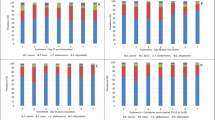Abstract
Coccidiosis, often caused by Eimeria zuernii, is an important disease in calf rearing and is clinically mainly associated with diarrhoea (PR Fitzgerald in Adv Vet Sci Comp Med, 24:121–143, 1980). Calves were experimentally infected with E. zuernii oocysts to investigate the effects of artificial E. zuernii coccidiosis on electrolyte concentrations, acid–base balance and blood gases. Therefore, animals were assigned to three groups: group 1 (n = 14) served as uninfected control group, group 2 (n = 11) was infected with 150,000 sporulated E. zuernii oocysts per calf, and group 3 (n = 16) was infected with 250,000 sporulated E. zuernii oocysts per calf. Aberrances which were attributed to coccidiosis were observed in the following parameters: sodium and chloride concentrations, pH (only high-dose infected group 3), base excess, standard bicarbonate, total carbon dioxide and partial pressure of carbon dioxide. Alterations were most pronounced in the high-dose infected group 3. Anion gap and oxygen saturation did not show significant differences between the groups. Due to diarrhoea and malabsorption in coccidiosis-affected calves, there is a distinct loss not only of fluid and blood but also of electrolytes and alkaline buffer substances which provokes the development of an acidosis. This is counteracted by metabolism and respiration but cannot be compensated in severely affected and moribund calves.







Similar content being viewed by others
References
Bangoura B, Daugschies A (2007) Parasitological and clinical parameters of experimental Eimeria zuernii infection in calves and influence on weight gain and haemogram. Parasitol Res 100(6):1331–1340
Daugschies A, Najdrowski M (2005) Eimerio sis in cattle: current understanding. J Vet Med B 52:417–427
Daugschies A, Buerger HJ, Akimaru M (1997) Effects of experimental infection with Eimeria bovis on the balance of sodium, potassium and water in calves. Parasitol Int 46:159–169
Ernst JV, Benz GW (1986) Intestinal coccidiosis in cattle. Vet Clin North Am Food Anim Pract 2:283–291
Fitzgerald PR (1967) Effect of bovine coccidiosis on blood serum sodium and potassium levels of calves. Am J Vet Res 28(124):667–670
Fitzgerald PR (1980) The economic impact of coccidiosis in domestic animals. Adv Vet Sci Comp Med 24:121–143
Fitzgerald PR, Mansfield ME (1972) Effects of bovine coccidiosis on certain blood components, feed consumption and body weight changes of calves. Am J Vet Res 33:1391–1397
Groutides C, Michell AR (1990) Evaluation of acid–base disturbances in calf diarrhoea. Vet Rec 126(2):29–31
Grove-White DH, Michell AR (2001) Comparison of the measurement of total carbon dioxide and strong ion difference for the evaluation of metabolic acidosis in diarrhoeic calves. Vet Rec 148:365–370
Kasari TR, Naylor JM (1986) Further studies on the clinical features and clinicopathological findings of a syndrome of metabolic acidosis with minimal dehydration in neonatal calves. Can J Vet Res 50:502–508
Keidel J (2005) Wirksamkeit von 0,25% Diclazuril (Vecoxan®) bei Kälberkokzidiose. Vet Med Rep 6:8
Kraft W (1999) Säure-Basen-Haushalt. In: Kraft W, Dürr M (ed) Klinische Labordiagnostik in der Tiermedizin, 5th edition. Schattauer Verlag, Stuttgart, pp 166–168
Marshall RN, Catchpole J, Green JA and Webster KA (1998) Bovine coccidiosis in calves following turnout. Vet Rec 143:366–367
Martin SW, Lumsden JH (1987) The relationship of hematology and serum chemistry parameters to treatment for respiratory disease and weight gain in Ontario feedlot calves. Can J Vet Res 51:499–505
Mundt HC, Bangoura B, Rinke M, Rosenbruch M, Daugschies A (2005a) Pathology and treatment of Eimeria zuernii coccidiosis in calves: Investigations in an infection model. Parasitol Int 54(4):223–230
Mundt HC, Bangoura B, Mengel H, Keidel J, Daugschies A (2005b) Control of clinical coccidiosis of calves due to Eimeria bovis and Eimeria zuernii with toltrazuril under field conditions. Parasitol Res 97(Suppl 1):S134–S142
Omole OO, Nappert G, Naylor JM, Zello GA (2001) Both l- and d-lactate contribute to metabolic acidosis in diarrheic calves. J Nutr 131:2128–2131
Roussel AJ, Cohen ND, Holland PS, Taliaoferro L, Green R, Benson P, Navarre CB, Hooper RN (1998) Alterations in acid–base balance and serum electrolyte concentrations in cattle: 632 cases (1984–1994). J Am Vet Med Assoc 212(11):1769–1775
Sahal M, Uensueren H, Imren HY (1993) Investigations concerning infusion treatment in neonatal diarrhoeic calves around Ankara with special consideration of their acidotic condition (1st communication). Dtsch Tierarztl Wschr 100:138–142
Steinhardt M, Gollnast I, Langanke M, Bunger U, Kutschke J (1993) Clinicochemical blood values in newborn calves. 2. Repeated studies in the same animals. Tierarztl Prax 21:405–411
Stockdale PHG, Niilo L (1976) Production of bovine coccidiosis with Eimeria zuernii. Can Vet J 17:35–37
Stockdale PHG, Bainborough AR, Bailey CB, Niilo L (1981) Some pathophysiologial changes associated with infection of Eimeria zuernii in calves. Can J Comp Med 45:34–37
Willuhn J (1999) Untersuchungen der Blutzusammensetzung und Charakterisierung peripherer Blutlymphozyten im Verlauf experimenteller E. bovis-Infektionen des Kalbes. Fachverlag Koehler, Giessen, pp 75–77
Acknowledgements
The authors wish to thank the Bayer HealthCare AG, Division Animal Health, Monheim, Germany for providing the study animals and stable facilities. In particular, thanks are given to Mr. A. Richter for statistical support and Dr. H.-C. Mundt for coordinational support. The experiment was conducted in compliance with current German laws and European guidelines.
Author information
Authors and Affiliations
Corresponding author
Rights and permissions
About this article
Cite this article
Bangoura, B., Daugschies, A. Influence of experimental Eimeria zuernii infection in calves on electrolyte concentrations, acid–base balance and blood gases. Parasitol Res 101, 1637–1645 (2007). https://doi.org/10.1007/s00436-007-0705-6
Received:
Accepted:
Published:
Issue Date:
DOI: https://doi.org/10.1007/s00436-007-0705-6



